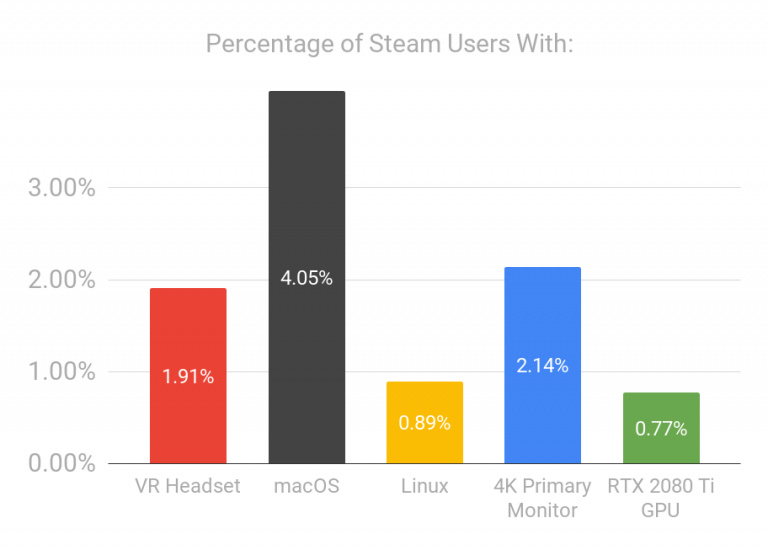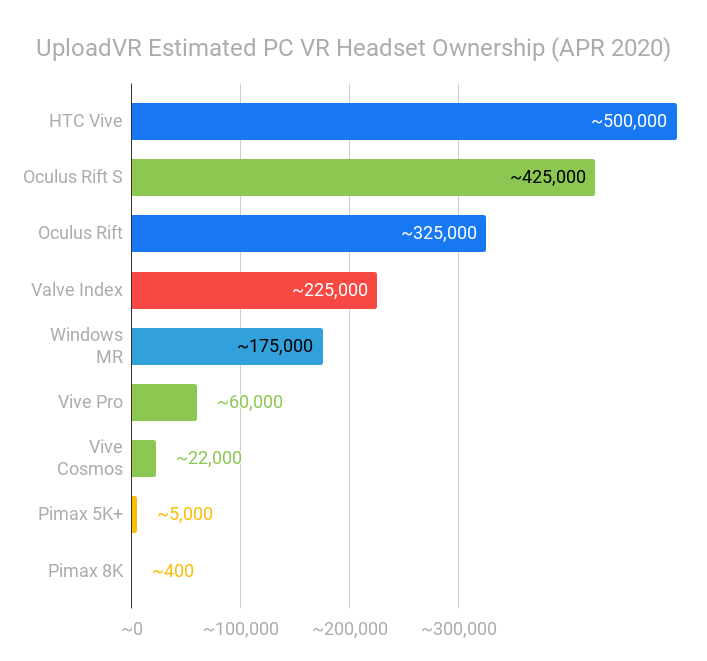Half-Life: Alyx Sees Steam User Base Double to 2 Million
The latest SteamVR hardware survey covering the month of April is out. According to the survey, the proportion of users with virtual reality headsets increased from 1.29% to 1.91%, coinciding with the period of the release and the subsequent success of Valve’s Half-Life: Alyx as well as the increasingly stiffer lockdown measures following the raging COVID-19 pandemic which has forced more people to stay indoors.
| March 2020 | % Increase | |
|---|---|---|
| HTC Vive | 26.07% | -0.59% |
| Oculus Rift S | 21.97% | -5.08% |
| Oculus Rift | 16.60% | +1.04%% |
| Valve Index | 11.94% | +1.00% |
| Windows Mixed Reality | 8.54% | +0.26% |
| Oculus Quest | 6.03% | +3.14% |
| HTC Vive Pro | 3.12% | -0.37% |
| HTC Vive Cosmos | 1.15% | -0.10% |
| PlayStation VR | 0.51% | -0.01% |
| Pimax 5K Plus | 0.27% | +0.00% |
| Oculus Rift DK2 | 0.07% | -0.04% |
| Pimax 8K | 0.02% | -0.04% |
| Oculus Rift DK1 | 0.01% | +0.01% |
| Huawei VR2 | 0.00% | -0.01% |
| Other | 3.69% | +0.78% |
| Steam Users with VR Headsets | 1.91% | +0.62% |
This is approximately an increase of 50%, a massive increase over a period of just one month. In April, Valve had changed how Steam reported virtual reality users. The data for the months of March and April can’t therefore be objectively compared to the data from the previous months.
Valve collects data on Steam users every month to establish the baseline statistics on the types of hardware and software used by its users and to track the shift in user behavior over time, including changes in the use of VR hardware.
The latest Steam hardware survey reflects the impact of the recent release of Half-Life: Alyx . The game came out in late March so the true extent wasn’t fully captured in the last month’s hardware survey as Valve collects most of its survey data early in the month.
The SteamVR hardware survey captures the number of headsets that have been connected to Steam in a given month. Valve defines the resulting figure as ‘monthly-connected headsets’ and it provides a fairly realistic approximation of the number of active users on Steam. However, the survey does not capture the number of headsets that were connected to Steam at any point during the month but were not used.
The launch of the Half-Life: Alyx in late March contributed to the massive jump in the monthly-connected headsets on the Steam platform.
Monthly-Connected Headsets on Steam
The 1.91% Steam user base from April may appear small but it is a considerable share when compared to other niche items captured on the Steam hardware survey. It shows that PC VR is still showing an impressive performance. If the current growth continues, then we are likely to see more PC VR headset users than 4K primary monitor users on Steam in the not so distant future.

The growth of the VR headset share from 1.29% to 1.91% represents the single-largest one-month leap in Steam users. The increase is almost thrice the increase that was witnessed in the December-January season when we saw an impressive jump in Steam users after the 2019 holiday season.
From the latest data, the number of Steam users who are connected to a virtual reality headset are now roughly twice that of users on Linux and is 50% as common as that of users who are using a MacOS. Steam announced this week that it is no longer supporting MacOS on SteamVR.
The Valve data gives us an indication on the number of the most popular virtual reality headsets on Steam. Steam typically provides this data as percentages of the total Steam population. The percentages appear small which obfuscates the true scale of the actual number of monthly-connected headsets.
To put it into perspective, it can be helpful to look at this in terms of the absolute numbers of the monthly-connected devices.
In April last year, Steam reported that it had hit 90 million monthly active users. For a quick approximation, let’s assume that this user base has since grown to 100 million. At the latest 1.91% of Steam users with a VR headset, we can estimate that there are now approximately 2 million users on Steam with a VR headset.
Based on the percentages from the Steam April Hardware Survey, here are the approximate numbers of the top virtual reality headsets in use on Steam: –

For the newer virtual reality headsets, the numbers above are as close as possible to the actual numbers of the respective virtual reality headsets that have been sold so far. Some of the older virtual reality headsets that have been around for years may likely be inoperable or in storage so the numbers in use on Steam do not necessarily give a close approximation of the total number of the headsets that are in circulation.
With inside-out tracking, it is now possible to have lower-cost virtual reality headsets that are easy to set up. The tracking technology has accounted for most of the virtual reality headset growth since May 2019 with sales mainly being driven by the Oculus Rift S headset. On Steam, 6 out of 10 virtual reality headsets are still tracked via external hardware due to the large number of the HTC Vive and Oculus Rift headsets that are still being used.
The Surge of Oculus Quest Headsets
The standalone Oculus Quest headset was designed to offer users room scale virtual reality without tethering to a gaming PC. However, with the Oculus Link connection, it is possible to use the Quest headset as a PC VR headset. This is done by connecting using a USB 3.0 cable. The Oculus PC connection can also be done wirelessly via a SideQuest patch on Virtual Desktop.
Due to the way the Quest PC connections work, Oculus Quest only began appearing on the Steam Hardware Survey in its March data that was released last month where it accounted for 2.89% of Steam users. For the month of April, the Quest share increased to 6.03%. This represents the single largest percentage growth for the VR headsets that have been featured on the Steam survey.
Most Oculus Quest headset owners don’t have a gaming PC. The social distancing and isolation following the COVID-19 pandemic could significantly drive PC sales because more consumers are now forced to spend more of their time at home alone. Also, the Quest stocks are now returning to the stores and this could also drive up PC sales.
The share of Oculus Rift S in the latest survey dropped from 27% to 22%, losing its market share to the original HTC Vive that was released in 2016. The fall in the Rift S share could also be due to Valve correcting the problem that caused the Quest headsets to be captured as Rift S in the Valve survey.
Steam Hardware Survey offers the most reliable indicator of the composition and size of the PC VR market but the data can be interpreted in multiple ways. It will be interesting to see how this market will grow for the rest of the year.
https://virtualrealitytimes.com/2020/05/04/half-life-alyx-sees-steam-user-base-double-to-2-million/https://virtualrealitytimes.com/wp-content/uploads/2017/02/steamvr_header-600x271.pnghttps://virtualrealitytimes.com/wp-content/uploads/2017/02/steamvr_header-150x90.pngBusinessThe latest SteamVR hardware survey covering the month of April is out. According to the survey, the proportion of users with virtual reality headsets increased from 1.29% to 1.91%, coinciding with the period of the release and the subsequent success of Valve’s Half-Life: Alyx as well as the increasingly...Sam OchanjiSam Ochanji[email protected]SubscriberVirtual Reality Times - Metaverse & VR
